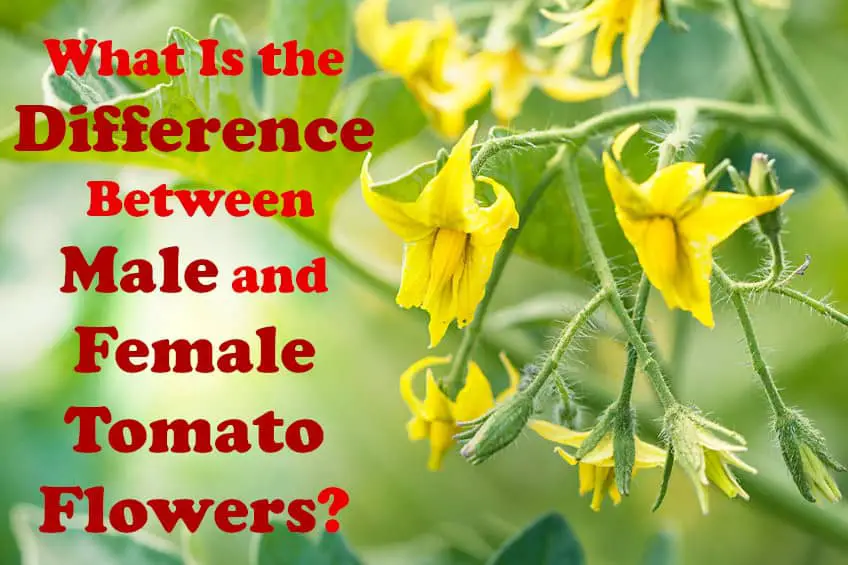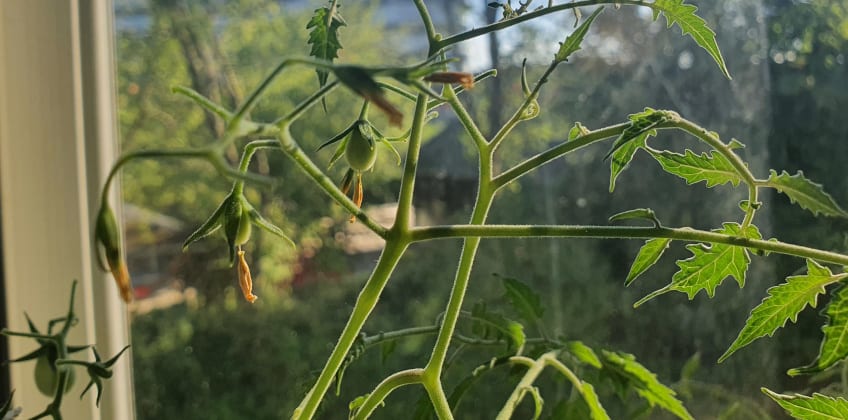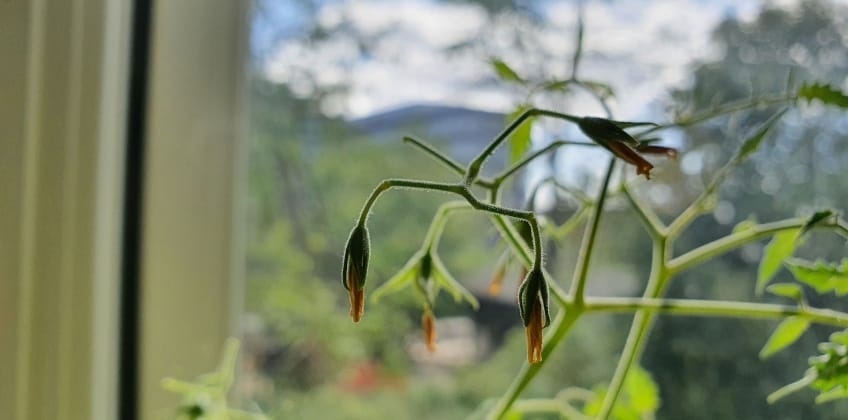This post contains affiliate links.
In order to hand-pollinate flowers, it is often necessary to know the difference between the males and females, but when it comes to tomato flowers, it is a little different than with many other plants. So how exactly can you tell male and female tomato flowers apart and what is the best way to hand-pollinate them? I answer both of those questions in this article.
Tomato plants are monoecious, meaning they bear both male and female reproductive parts. Each flower is both male and female. As a monoecious plant, tomatoes can self-pollinate and do not depend on other plants and pollinators such as bees to produce fruit.
In this post, I cover what you should know about male and female flowers on tomato plants and how you can apply that knowledge in your garden so you can improve your tomato production significantly by hand pollinating your tomato flowers.

Are Tomato Male and Female Flowers Different? Explained
Like animals, plants have reproductive parts. They need them for pollination. Some garden plants, such as squash, have single-sex flowers that are either male or female, and some plants have flowers that are both male and female (source).
The flowers on tomato plants are both male and female at the same time. This is called being monoecious. Tomato flowers contain anthers and pistils. The anthers are the male reproductive parts that contain the pollen, and the pistils are the female parts that receive the pollen and produce fruit and seeds.
I have written another article where I cover everything about why tomato plants flower, what to do, and much more related to tomato flowering. So if you are interested in that, I recommend that you read it. You can find it on this link.
It is actually a big advantage for tomato plants that they are monoecious because it makes it much easier for their flowers to become pollinated.
Having flowers that are both male and female at the same time allows tomato plants to self-pollinate quite easily and efficiently. Self-pollination essentially means that the pollen from the male parts of the plant’s flowers is used to pollinate the female parts of the same flower or other flowers on the same plant.
Many plants rely on insects such as bees for pollination. While they definitely can help tomato flowers become pollinated, tomato plants do not depend on bees or other insects for pollination. You can read more about that on this link.
Since each tomato flower has both male and female reproductive parts, being exposed to a bit of wind is usually enough for the flowers to shake or vibrate enough to become pollinated.
If you want to be sure that as many of the flowers on your tomato plant as possible are being pollinated and produce fruit, you can help your plant a bit by hand pollinating the flowers. I explain how to do that below.
4 Ways to Hand Pollinate Tomato Flowers and Get More Fruit

In my experience, tomato plants are usually really good at pollinating themselves and producing fruit and seeds, and insects such as bees can often make it even more efficient.
But there are a few ways you can make sure that even more of your tomato flowers are getting pollinated, so you get even more fruit from your plant.
Picking a tomato variety that produces a lot of fruit is the first step to getting a high yield (read more here), but hand-pollination can also be a really efficient way to ensure a larger yield. If you aren’t sure which type your tomato plant is, I have written another post to help you find out.
Hand-pollination basically means that you manually help your tomato flowers become pollinated. It is really easy.
Here are my 4 favorite ways to hand-pollinate tomato flowers:
- Tap the plant lightly to shake the flowers and make the pollen touch the pistils (the female reproductive part).
This is by far the easiest way to hand-pollinate tomato flowers in my experience. Be careful not to tap the plant too hard as it can take damage. A few light taps on different parts of the main stem usually do the trick.
- Use a small fine paint or art brush to gather the pollen and spread it around the flower.
Use the soft tip of the brush to lightly touch the flower everywhere on the petals, anthers, and pistils. You can basically just rub the brush all over the inside of the flower to be sure. Be very gentle when you do this, and make sure not to use the same brush for different tomato varieties to avoid cross-pollination.
- Use a vibrating device such as a toothbrush to shake the flower and make the pollen spread all over the flower.
You should also be a bit careful not to damage the plant when you do this. Just place the vibrating device on the stem right behind a flower to make the flower shake and loosen its pollen. That way, the pollen will be spread all over the flower, and you can be almost sure it has been pollinated.
- Collect the pollen in a small container and use a cotton swab to rub it onto the end of the flower’s stigma (the tiny little green part at the center of the flower).
This way is a little more complicated but can work really well.
The easiest way to collect the pollen is to place a flower or a group of flowers above or in a small container (without removing them from the plant, of course) and then shake it. That will loosen the pollen and make it fall into the container, and then you can just use a cotton swab to collect it and rub it onto the flowers.
Of course, when you shake the flowers to loosen the pollen, some of the flowers will likely already become pollinated, so this is a way to ensure that even more flowers do.
How to Tell if a Tomato Flower Has Been Pollinated
If there are many insects such as bees flying around your tomato plants, there is a really good chance that the flowers have been pollinated successfully, but that in itself is not enough to be sure. Luckily, there are ways to tell for sure.

It takes a few days from the flowers being pollinated before you can actually see it, so don’t expect anything to happen right away, but keep an eye on your tomato flowers.
Here are some ways to tell if a tomato flower has been pollinated:
- You can see the stem right behind the flower begin to get larger and round. This is a small tomato that is beginning to form, and you will soon be able to see the actual fruit.
- Look at the stem. If the stem right behind a flower is getting yellow, it means the flower has not been pollinated and is dying. If the stem stays green and the stem right behind the flower begins to get larger, it means that is has been pollinated.
- Look if the flowers are wilting. Wilting usually occurs within a day after the flower being pollinated, so if you see the flowers begin to wilt, it is usually a good sign.
It can be a lot easier to see these signs if you use a magnifying glass. It can help you see a lot of the small details on your plants including checking if a tomato flower has been pollinated. In addition to that, it is just really cool to be able to see some of the tiny details on your plants. At least I think so.
Even though a tomato flower has been pollinated, things can happen, and the flower and fruit can die.
The only way to be completely confident that a tomato plant will produce fruit is that you can see the tiny green tomato where the flower is or used to be.
Tomato plants usually die once they are done producing fruit, but if you live in an area with the right conditions, you can actually sometimes keep the plant alive and producing fruit for more than just one season. I have another article where you can read more about that on this link.
If your tomato flowers have been pollinated and you have picked and eaten the fruit, you will probably realize that it tastes so much better than any tomato you can find in a store. If that is the case (and I hope it is), I have a cool trick you can use to clone the plant and get a lot more of the same variety for free. I have a guide for it on this link.

